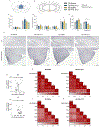Poly (I:C)-induced maternal immune activation modifies ventral hippocampal regulation of stress reactivity: prevention by environmental enrichment
- PMID: 33766701
- PMCID: PMC8187276
- DOI: 10.1016/j.bbi.2021.03.018
Poly (I:C)-induced maternal immune activation modifies ventral hippocampal regulation of stress reactivity: prevention by environmental enrichment
Abstract
Environmental enrichment (EE) has been successfully implemented in human rehabilitation settings. However, the mechanisms underlying its success are not understood. Incorporating components of EE protocols into our animal models allows for the exploration of these mechanisms and their role in mitigation. Using a mouse model of maternal immune activation (MIA), the present study explored disruptions in social behavior and associated hypothalamic pituitary adrenal (HPA) axis functioning, and whether a supportive environment could prevent these effects. We show that prenatal immune activation of toll-like receptor 3, by the viral mimetic polyinosinic-polycytidylic acid (poly(I:C)), led to disrupted maternal care in that dams built poorer quality nests, an effect corrected by EE housing. Standard housed male and female MIA mice engaged in higher rates of repetitive rearing and had lower levels of social interaction, alongside sex-specific expression of several ventral hippocampal neural stress markers. Moreover, MIA males had delayed recovery of plasma corticosterone in response to a novel social encounter. Enrichment housing, likely mediated by improved maternal care, protected against these MIA-induced effects. We also evaluated c-Fos immunoreactivity associated with the novel social experience and found MIA to decrease neural activation in the dentate gyrus. Activation in the hypothalamus was blunted in EE housed animals, suggesting that the putative circuits modulating social behaviors may be different between standard and complex housing environments. These data demonstrate that augmentation of the environment supports parental care and offspring safety/security, which can offset effects of early health adversity by buffering HPA axis dysregulation. Our findings provide further evidence for the viability of EE interventions in maternal and pediatric settings.
Keywords: Autism; CamkIIa, Protein Kinase; Corticotropin releasing factor; Corticotropin releasing hormone receptor; Fetal programming; Glucocorticoid receptor; Hippocampus; Inflammation; Maternal behavior; Maternal care; Oxytocin; Poly I:C; Prefrontal cortex; Schizophrenia; Sex difference; Social approach; Social vigilance; Suprammamillary nucleus; Synaptic plasticity; Vasopressin; cFos.
Copyright © 2021 Elsevier Inc. All rights reserved.
Conflict of interest statement
Declaration of Competing Interest
The authors declare that they have no known competing financial interests or personal relationships that could have appeared to influence the work reported in this paper.
Figures




Similar articles
-
Maternal immune activation accelerates puberty initiation and alters mechanical allodynia in male and female C57BL6/J mice.Dev Psychobiol. 2022 Jul;64(5):e22278. doi: 10.1002/dev.22278. Dev Psychobiol. 2022. PMID: 35603415 Free PMC article.
-
Environmental enrichment mitigates the sex-specific effects of gestational inflammation on social engagement and the hypothalamic pituitary adrenal axis-feedback system.Brain Behav Immun. 2014 Nov;42:178-90. doi: 10.1016/j.bbi.2014.06.020. Epub 2014 Jul 7. Brain Behav Immun. 2014. PMID: 25011058
-
Therapeutic efficacy of environmental enrichment on behavioral, endocrine, and synaptic alterations in an animal model of maternal immune activation.Brain Behav Immun Health. 2020 Mar;3:100043. doi: 10.1016/j.bbih.2020.100043. Epub 2020 Jan 30. Brain Behav Immun Health. 2020. PMID: 32368757 Free PMC article.
-
The Outcomes of Maternal Immune Activation Induced with the Viral Mimetic Poly I:C on Microglia in Exposed Rodent Offspring.Dev Neurosci. 2023;45(4):191-209. doi: 10.1159/000530185. Epub 2023 Mar 21. Dev Neurosci. 2023. PMID: 36944325 Review.
-
[Impact of Maternal Stress in Pregnancy on Brain Function of the Offspring].Nihon Eiseigaku Zasshi. 2016;71(3):188-194. doi: 10.1265/jjh.71.188. Nihon Eiseigaku Zasshi. 2016. PMID: 27725421 Review. Japanese.
Cited by
-
Maternal immune activation affects socio-communicative behavior in adult rats.Sci Rep. 2023 Feb 2;13(1):1918. doi: 10.1038/s41598-023-28919-z. Sci Rep. 2023. PMID: 36732579 Free PMC article.
-
Maternal immune activation accelerates puberty initiation and alters mechanical allodynia in male and female C57BL6/J mice.Dev Psychobiol. 2022 Jul;64(5):e22278. doi: 10.1002/dev.22278. Dev Psychobiol. 2022. PMID: 35603415 Free PMC article.
-
Got milk? Maternal immune activation during the mid-lactational period affects nutritional milk quality and adolescent offspring sensory processing in male and female rats.Mol Psychiatry. 2022 Dec;27(12):4829-4842. doi: 10.1038/s41380-022-01744-y. Epub 2022 Sep 2. Mol Psychiatry. 2022. PMID: 36056174 Free PMC article.
-
Sex differences in offspring risk and resilience following 11β-hydroxylase antagonism in a rodent model of maternal immune activation.Neuropsychopharmacology. 2024 Jun;49(7):1078-1090. doi: 10.1038/s41386-023-01771-5. Epub 2023 Nov 25. Neuropsychopharmacology. 2024. PMID: 38007547 Free PMC article.
-
Maternal immune activation with toll-like receptor 7 agonist during mid-gestation alters juvenile and adult developmental milestones and behavior.J Neuroendocrinol. 2024 Aug;36(8):e13417. doi: 10.1111/jne.13417. Epub 2024 Jun 1. J Neuroendocrinol. 2024. PMID: 38822791 Free PMC article.
References
-
- Allen Institute for Brain Science., 2011. Allen Mouse Brain Atlas. Available from http://mouse.brain-map.org/static/atlas.
Publication types
MeSH terms
Substances
Grants and funding
LinkOut - more resources
Full Text Sources
Other Literature Sources

